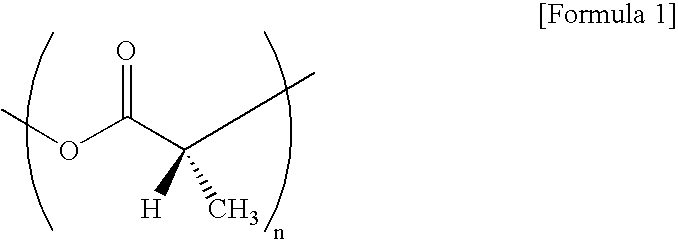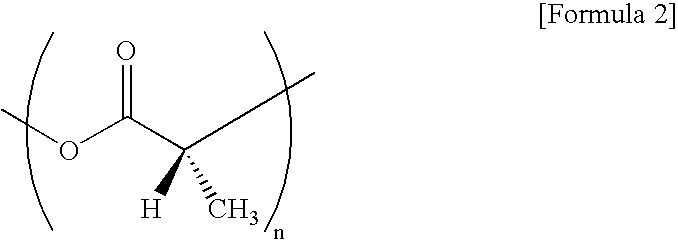Aliphatic polyester composition and its molded article
a technology of aliphatic polyester and composition, applied in the direction of synthetic resin layered products, layered products, chemistry apparatus and processes, etc., can solve the problems that skilled in the art do not conventionally recognize, and achieve the effects of improving crystallization rate, high heat resistance, and maintaining thermal stability
- Summary
- Abstract
- Description
- Claims
- Application Information
AI Technical Summary
Benefits of technology
Problems solved by technology
Method used
Image
Examples
example 1
[0070] First, L-lactide (made by Aldrich, 10 g), 1-dodecanol (made by Wako Pure Chemical Industries, Ltd., 1.0 g), and Tin 2-ethylhexanoate (made by Wako Pure Chemical Industries, Ltd., 0.008ml) were mixed and the mixture was reacted for one hour at 160° C., thereafter being cooled down to room temperature. Next, a product was melted using chloroform and the resultant was reprecipitated using methanol / HCl (1%) filtered and washed, thereby obtaining white low-molecular-weight poly-L-lactic acids.
[0071] Next, high-molecular-weight poly-L-lactic acid of 0.5 g (made by Toyota Jidosha Kabushiki Kaisha, #5000, weight-average molecular weight (Mw)=215000), the above-obtained low-molecular-weight poly-L-lactic acid of 0.5 g (weight-average molecular weight (Mw)=6900) and ethylene-bis-12-hydroxystearamide of 0.01 g (made by Kawaken Fine Chemicals Co., Ltd., hereinafter referred to as “EBHSA”) were mixed using chloroform of 10 ml while being stirred. The obtained mixture was dropped on a pet...
examples 2 to 4
[0075] Low-molecular-weight poly-L-lactic acid with weight-average molecular weight (Mw) of 9200 (Example 2), one with weight-average molecular weight (Mw) of 29600 (Example 3) and one with weight-average molecular weight (Mw) of 34200 (Example 4) were used. Excepting the use of these polylactic acids, a film of a polylactic acid resin composition was prepared and the above DSC measurement was made using the obtained film as the sample in the same manner as that of Example 1. The obtained results are shown in Table 1.
example 5
[0076] Excepting the use of high-molecular-weight poly-L-lactic acid with weight-average molecular weight (Mw) of 451000, a film of a polylactic acid resin composition was prepared and the above DSC measurement was made using the obtained film as the sample in the same manner as that of Example 1. The obtained result is shown in Table 1.
PUM
| Property | Measurement | Unit |
|---|---|---|
| particle size | aaaaa | aaaaa |
| temperature | aaaaa | aaaaa |
| temperature | aaaaa | aaaaa |
Abstract
Description
Claims
Application Information
 Login to View More
Login to View More - R&D
- Intellectual Property
- Life Sciences
- Materials
- Tech Scout
- Unparalleled Data Quality
- Higher Quality Content
- 60% Fewer Hallucinations
Browse by: Latest US Patents, China's latest patents, Technical Efficacy Thesaurus, Application Domain, Technology Topic, Popular Technical Reports.
© 2025 PatSnap. All rights reserved.Legal|Privacy policy|Modern Slavery Act Transparency Statement|Sitemap|About US| Contact US: help@patsnap.com



